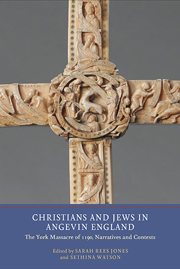Book contents
- Frontmatter
- Contents
- List of Illustrations
- Contributors
- Editor's Preface and Acknowledgments
- Abbreviations
- Introduction: The Moment and Memory of the York Massacre of 1190
- Part I The Events of March 1190
- 1 Neighbours and Victims in Twelfth-Century York: a Royal Citadel, the Citizens and the Jews Of York
- 2 Prelude and Postscript to the York Massacre: Attacks in East Anglia and Lincolnshire, 1190
- 3 William of Newburgh, Josephus and the New Titus
- 4 1190, William Longbeard and the Crisis of Angevin England
- 5 The Massacres of 1189-90 and the Origins of the Jewish Exchequer, 1186–1226
- Part II Jews among Christians in Medieval England
- Part III Representations
- Afterword: Violence, Memory and the Traumatic Middle Ages
- Bibliography
- Index
- York Medieval Press: Publications
1 - Neighbours and Victims in Twelfth-Century York: a Royal Citadel, the Citizens and the Jews Of York
from Part I - The Events of March 1190
Published online by Cambridge University Press: 05 May 2013
- Frontmatter
- Contents
- List of Illustrations
- Contributors
- Editor's Preface and Acknowledgments
- Abbreviations
- Introduction: The Moment and Memory of the York Massacre of 1190
- Part I The Events of March 1190
- 1 Neighbours and Victims in Twelfth-Century York: a Royal Citadel, the Citizens and the Jews Of York
- 2 Prelude and Postscript to the York Massacre: Attacks in East Anglia and Lincolnshire, 1190
- 3 William of Newburgh, Josephus and the New Titus
- 4 1190, William Longbeard and the Crisis of Angevin England
- 5 The Massacres of 1189-90 and the Origins of the Jewish Exchequer, 1186–1226
- Part II Jews among Christians in Medieval England
- Part III Representations
- Afterword: Violence, Memory and the Traumatic Middle Ages
- Bibliography
- Index
- York Medieval Press: Publications
Summary
Barrie Dobson's wide-ranging and richly-detailed study of the massacre of the Jews of York in March 1190 remains the definitive history of that terrible event. Most importantly he demonstrated that the massacre did not mark the end of a Jewish community in the city but rather occurred near its beginning: very soon after their first settlement under Josce and Benedict of York in the 1170s and 1180s. The return of Jews to York after 1190, and the new Jewish community which flourished in the early thirteenth century, was the subject of later papers by Dobson, now reprinted in a single volume. Here we do not try to cover the same ground. Where Dobson's history focussed on the Jews of York and the national context for the events in March 1190, this chapter deals in more depth with the city of York itself, both as a place and as a community in the later twelfth century. Modern memorialization of the massacre of March 1190 has become indelibly associated with Clifford's Tower, at the foot of which there is now a plaque of commemoration for the victims of 1190. Yet this stone structure was built some fifty years after the massacre and named another eighty years after that: it was not the structure in which the massacre occurred. The stone tower does stand on the site of a previous wooden castle keep, which stood on top of a smaller earth motte at the centre of a castle first constructed by William the Conqueror in 1068-69. It is usually assumed that this was the site of the mass suicide and murder of the Jews in March 1190.
- Type
- Chapter
- Information
- Christians and Jews in Angevin EnglandThe York Massacre of 1190, Narratives and Contexts, pp. 15 - 42Publisher: Boydell & BrewerPrint publication year: 2013



